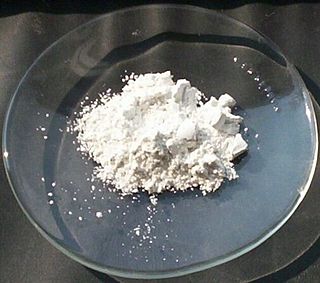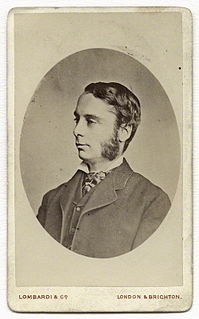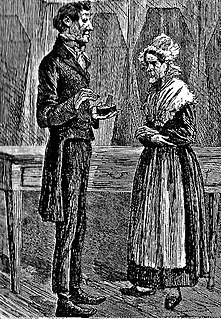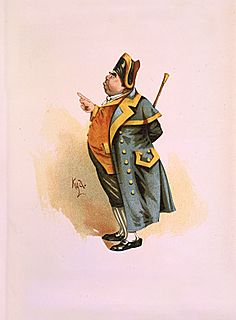
Antimony is a chemical element with the symbol Sb (from Latin: stibium) and atomic number 51. A lustrous gray metalloid, it is found in nature mainly as the sulfide mineral stibnite (Sb2S3). Antimony compounds have been known since ancient times and were powdered for use as medicine and cosmetics, often known by the Arabic name kohl. The earliest known description of the metal in the West was written in 1540 by Vannoccio Biringuccio.

Oliver! is a coming-of-age stage musical, with book, music and lyrics by Lionel Bart. The musical is based upon the 1838 novel Oliver Twist by Charles Dickens.

A pnictogen is any of the chemical elements in group 15 of the periodic table. Group 15 is also known as the nitrogen group or nitrogen family. It consists of the elements nitrogen (N), phosphorus (P), arsenic (As), antimony (Sb) and bismuth (Bi). Even though unconfirmed, the synthetic element moscovium (Mc) is predicted to be a pnictogen as well.

Antimony(III) oxide is the inorganic compound with the formula Sb2O3. It is the most important commercial compound of antimony. It is found in nature as the minerals valentinite and senarmontite. Like most polymeric oxides, Sb2O3 dissolves in aqueous solutions with hydrolysis. A mixed arsenic-antimony oxide occurs in nature as the very rare mineral stibioclaudetite.

Cutaneous leishmaniasis is the most common form of leishmaniasis affecting humans. It is a skin infection caused by a single-celled parasite that is transmitted by the bite of a phlebotomine sand fly. There are about thirty species of Leishmania that may cause cutaneous leishmaniasis.

A carbenium ion is a positive ion with the structure RR′R″C+, that is, a chemical species with a trivalent carbon that bears a +1 formal charge.

Antimony oxychloride, known since the 15th century, has been known by a plethora of alchemical names. Since the compound functions as both an emetic and a laxative, it was originally used as a purgative.

An antimonial cup was a small half-pint mug or cup cast in antimony popular in Europe during the 17th and 18th centuries. They were also known under the names "pocula emetica," "calices vomitorii," or "emetic cups", as wine that was kept in one for a 24‑hour period gained an emetic or laxative quality. The tartaric acid in the wine acted upon the metal cup and formed tartarised antimony.
Glass of antimony, vitrum antimonii, is a yellow to red, translucent glass created from a preparation of antimony, though historically used as an emetic, the glass was a subject of much interest from alchemists due to its unusual properties. It was created using crude antimony, ground and calcined by a vehement fire, in an earthen crucible, until it no longer fumed, indicating that its sulfur was evaporated. The remaining substance was then vitrified in a wind furnace, and stirred with an iron rod, upon which it became translucent and displayed a ruddy and shining yellow-red color.
Kermes mineral or Alkermes mineral was a compound of antimony oxides and sulfides, more specifically, antimony trioxide and trisulfide. It can be made or obtained in the laboratory by the actions of potassium carbonate (K2CO3) on antimony sulfide. The compound is reddish brown in color and described as a velvety powder which is insoluble in water. It was used extensively in the medical field until the general use of antimony compounds declined due to toxic effects.
Pentavalent antimonials are a group of compounds used for the treatment of leishmaniasis. They are also called pentavalent antimony compounds.

Sodium stibogluconate, sold under the brand name Pentostam among others, is a medication used to treat leishmaniasis. This includes leishmaniasis of the cutaneous, visceral, and mucosal types. Some combination of miltefosine, paramycin and liposomal amphotericin B, however, may be recommended due to issues with resistance. It is given by injection.

Meglumine antimoniate is a medicine used to treat leishmaniasis. This includes visceral, mucocutaneous, and cutaneous leishmaniasis. It is given by injection into a muscle or into the area infected.

Charles Delauney Bravo was a British lawyer who was fatally poisoned with antimony in 1876.The case is still sensational, notorious and unresolved. The case is also known as The Charles Bravo Murder and the Murder at the Priory.
Julian Bleach is an English actor, singer and playwright, who is known as co-creator and "MC" of Shockheaded Peter, a musical entertainment based on the works of Heinrich Hoffmann, which won the 2002 Olivier Award for Best Entertainment. He is also known for playing Davros in the 2005 revival of Doctor Who.
An antimony pill is a pill made from metallic antimony. It was a popular remedy in the nineteenth century, and it was used to purge and revitalise the bowels. In use, it is swallowed and allowed to pass through the body, after which it is customarily recovered for reuse, giving rise to the name everlasting pill. The antimonial cup yielded the same effect.

Antimony potassium tartrate, also known as potassium antimonyl tartrate, potassium antimontarterate, or tartar emetic, has the formula K2Sb2(C4H2O6)2. The compound has long been known as a powerful emetic, and was used in the treatment of schistosomiasis and leishmaniasis. It is used as a resolving agent. It typically is obtained as a hydrate.

Mr Sowerberry is a fictional character who appears as a supporting antagonist in Charles Dickens' 1838 novel Oliver Twist. He is an undertaker and coffin maker who owns and operates a small dark shop in a small town some 75 mi (121 km) from London. This shop also serves as a dwelling for himself, his wife, a maidservant named Charlotte, an assistant named Noah Claypole, and, for a short period, as an apprentice, the protagonist of the novel, a young boy named Oliver Twist who has been "purchased" from the local parish workhouse.

Mr. Bumble is a fictional character and minor antagonist in the 1838 novel Oliver Twist by Charles Dickens.

The hexafluoroarsenate anion is a chemical species with formula AsF−6. Hexafluoroarsenate is relatively inert, being the conjugate base of the notional superacid hexafluoroarsenic acid.















